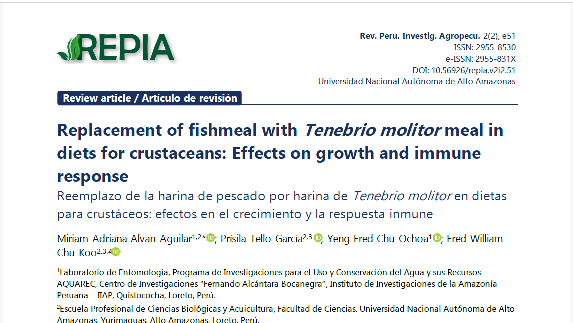Reemplazo de la harina de pescado por harina de Tenebrio molitor en dietas para crustáceos: efectos en el crecimiento y la respuesta inmune
DOI:
https://doi.org/10.56926/repia.v2i2.51Palabras clave:
acuicultura, alimentación, insectos, crustáceos, saludResumen
El uso de harina de pescado (FM) como fuente proteica en la acuicultura es una de las principales críticas sobre esta industria. Aumentar la producción de un modo más sostenible es un imperativo actual para este sector. Por otra parte, la cría de insectos se ha tornado en una alternativa prometedora para la alimentación acuícola, ya que varias especies pueden producirse usando residuos orgánicos. Los insectos son organismos ricos en nutrientes, alta energía, y un perfil equilibrado de aminoácidos, a diferencia de las fuentes proteicas vegetales que son deficientes en ciertos aminoácidos esenciales. El objetivo del manuscrito es presentar una revisión de las investigaciones recientes sobre la sustitución de la FM por la harina de larvas de Tenebrio molitor (TMM), un coleóptero que se ha vuelto popular como alternativa en dietas acuícolas y sus efectos en el crecimiento y la respuesta inmune en crustáceos. Los estudios indican que la TMM puede sustituir completamente a la FM en Litopenaeus vannamei, mientras que los niveles de sustitución que funcionaron mejor para Macrobrachium rosenbergii y el cangrejo de río van desde 12 a 50%. No se encontraron estudios en crustáceos amazónicos ni sudamericanos, lo que abre oportunidades para nuevas líneas de investigación.
Descargas
Citas
Choi, I. H.; Kim, J. M.; Kim, N. J.; Kim, J. D.; Park, C.; Park, J. H.; & Chung, T. H. (2018). Replacing fish meal by mealworm (Tenebrio molitor) on the growth performance and immunologic responses of white shrimp (Litopenaeus vannamei). Acta Scientiarum - Animal Sciences, 40, 1–9. https://doi.org/10.4025/actascianimsci.v40i1.39077
Costa-Pierce, B.A.; & Chopin, T. (2021). The hype, fantasies, and realities of aquaculture development globally and its new geographies. World Aquaculture Magazine, 52: 23-35.
Dawood, M.A. (2021). Nutritional immunity of fish intestines: important insights for sustainable aquaculture. Reviews in Aquaculture, 13(1):642e63. https://doi.org/10.1111/raq.12492.
Feng, P.; He, J.; Huang, G.; Chen, X.; Yang, Q.; Wang, J.; Wang, D.; & Ma, H. (2019). Effect of dietary Tenebrio molitor protein on growth performance and immunological parameters in Macrobrachium rosenbergii. Aquaculture, 511, 734247. https://doi.org/10.1016/j.aquaculture.2019.734247
Food and Agriculture Organization of the United Nations – FAO (2021). Fishery and Aquaculture Statistics. Global aquaculture production 1950-2019 (FishstatJ). FAO, Rome, Italy. Available at: www.fao.org/fishery/statistics/software/fishstatj/en
Gasco, L.; Henry, M.; Piccolo, G.; Marono, S.; Gai, F.; Renna, M.; Lussiana, C.; Antonopoulou, E.; Mola, P.; & Chatzifotis, S. (2016). Tenebrio molitor meal in diets for European sea bass (Dicentrarchus labrax L.) juveniles: Growth performance, whole body composition and in vivo apparent digestibility. Animal Feed Science and Technology, 220, 34–45. https://doi.org/10.1016/j.anifeedsci.2016.07.003
Gu, J., Liang, H., Ge, X., Xia, D., Pan, L., Mi, H., & Ren, M. (2022). A study of the potential effect of yellow mealworm (Tenebrio molitor) substitution for fish meal on growth, immune and antioxidant capacity in juvenile largemouth bass (Micropterus salmoides). Fish and Shellfish Immunology, 120(October 2021), 214–221. https://doi.org/10.1016/j.fsi.2021.11.024
Henry, M.A.; Gai, F.; Enes, P.; Pérez-Jiménez, A.; & Gasco, L. (2018). Effect of partial dietary replacement of fishmeal by yellow mealworm (Tenebrio molitor) larvae meal on the innate immune response and intestinal antioxidant enzymes of rainbow trout (Oncorhynchus mykiss). Fish and Shellfish Immunology, 8: 83:30. 8e13. https://doi.org/10.1016/j.fsi.2018.09.040.
Hoffmann, L.; Rawski, M.; Nogales-Mérida, S.; Kołodziejski, P.; Pruszyńska-Oszmałek, E.; & Mazurkiewicz, J. (2021). Mealworm meal use in sea trout (Salmo trutta m. trutta, L.) fingerling diets: effects on growth performance, histomorphology of the gastrointestinal tract and blood parameters. Aquaculture Nutrition, 27(5), 1512–1528. https://doi.org/10.1111/anu.13293
Iaconisi, V.; Bonelli, A.; Pupino, R.; Gai, F.; & Parisi, G. (2018). Mealworm as dietary protein source for rainbow trout: Body and fillet quality traits. Aquaculture, 484: 197–204. https://doi.org/10.1016/j.aquaculture.2017.11.034
Iaconisi, V.; Marono, S.; Parisi, G.; Gasco, L.; Genovese, L.; Maricchiolo, G.; Bovera, F.; & Piccolo, G. (2017). Dietary inclusion of Tenebrio molitor larvae meal: Effects on growth performance and final quality treats of blackspot sea bream (Pagellus bogaraveo). Aquaculture, 476: 49–58. https://doi.org/10.1016/j.aquaculture.2017.04.007
Ido, A.; Hashizume, A.; Ohta, T.; Takahashi, T.; Miura, C.; & Miura, T. (2019). Replacement of fish meal by defatted yellow mealworm (Tenebrio molitor) larvae in the diet improves growth performance and disease resistance in red seabream (Pargus major). Animals, 9(3):100. https://doi.org/10.3390/ani9030100.
Jeong, S. M.; Khosravi, S.; Mauliasari, I. R.; & Lee, S. M. (2020). Dietary inclusion of mealworm (Tenebrio molitor) meal as an alternative protein source in practical diets for rainbow trout (Oncorhynchus mykiss) fry. Fisheries and Aquatic Sciences, 23(1): 214–221. https://doi.org/10.1186/s41240-020-00158-7
Li, X.Y.; Chen, Y.K.; Zheng, C.Z.; Chi, S.Y.; Zhang, S.; Tan, B.P.; & Xie, S.W. (2022). Evaluation of six novel protein sources on apparent digestibility in Pacific White Shrimp, Litopenaeus vannamei. Aquaculture Nutrition. https://doi.org/10.1155/2022/8225273.
Makkar, H.P.S.; Tran, G.; Heuzé, V.; & Ankers, P. (2014). State-of-the-art on use of insects as animal feed. Animal Feed Science and Technology, 197: 1-33. https://doi.org/10.1016/j.anifeedsci.2014.07.008
Mastoraki, M.; Vlahos, N.; Patsea, E.; Chatzifotis, S.; Mente, E.; & Antonopoulou, E. (2020). The effect of insect meal as a feed ingredient on survival, growth, and metabolic and antioxidant response of juvenile prawn Palaemon adspersus (Rathke, 1837). Aquaculture Research, 51: 3551-3562. https://doi.org/10.1111/are.14692
Mazlum, Y.; Turan, F.; & Bircan, Y. (2021). Evaluation of mealworms (Tenebrio molitor) meal as an alternative protein source for narrow-clawed crayfish (Pontastacus leptodactylus) juveniles. Aquaculture Research. 1–9. https://doi.org/10.1111/are.15253
Melenchón, F.; Larrán, A. M.; de Mercado, E.; Hidalgo, M. C.; Cardenete, G.; Barroso, F. G.; Fabrikov, D.; Lourenço, H. M.; Pessoa, M. F.; & Tomás-Almenar, C. (2021). Potential use of black soldier fly (Hermetia illucens) and mealworm (Tenebrio molitor) insectmeals in diets for rainbow trout (Oncorhynchus mykiss). Aquaculture Nutrition, 27(2): 491–505. https://doi.org/10.1111/ANU.13201
Naylor, R.L.; Hardy, R.W.; Buschmann, A.H.; Bush, S.R.; Cao, L.; Klinger, D.H.; Little, D.C.; Lubchenco, J.; Shumway, S.E.; & Troell, M. (2021). A 20-year retrospective review of global aquaculture. Nature, 591: 551-563. https://doi.org/10.1038/s41586-021-03308-6
Panini, R. L.; Freitas, L. E. L.; Guimarães, A. M.; Rios, C.; da Silva, M. F. O.; Vieira, F. N.; Fracalossi, D. M.; Samuels, R. I.; Prudêncio, E. S.; Silva, C. P.; & Amboni, R. D. M. C. (2017). Potential use of mealworms as an alternative protein source for Pacific white shrimp: Digestibility and performance. Aquaculture, 473: 115–120. https://doi.org/10.1016/j.aquaculture.2017.02.008
Rema, P.; Saravanan, S.; Armenjon, B.; Motte, C.; & Dias, J. (2019). Graded incorporation of defatted yellow mealworm (Tenebrio molitor) in rainbow trout (Oncorhynchus mykiss) diet improves growth performance and nutrient retention. Animals, 9(4). https://doi.org/10.3390/ani9040187
Ríos, C.; Panini, R.L.; Acordi Menezes, L.A.; Vieira, F.N.; Fracalossi, D.M.; Samuels, R.I.; De Dea Lindner, J.; & Silva, C.P. (2021). Effects of the substitution of fishmeal with mealworm meal on enzymes, haemolymph and intestinal microbiota of the Pacific white shrimp. Journal of Insects as Food and Feed, 7(6): 1023–1033. https://doi.org/10.3920/JIFF2020.0148
Roncarati, A.; Gasco, L.; Parisi, G.; & Terova, A. (2015). Growth performance of common catchfish (Ameiurus melas Raf.) fingerlings fed mealworm (Tenebrio molitor) diet. Journal of Insects as Food and Feed, 1(3): 233 - 240. https://doi.org/10.3920/JIFF2014.0006
Röthig, T.; Vilcinskas, A.; Barth, A.; Tschirner, M.; Schubert, P.; Wenning, M.; Billion, A.; & Wilke, T. (2023). Insect feed in sustainable crustacean aquaculture. Journal of Insects as Food and Feed, 9(9): 1115-1138. https://doi.org/10.3920/JIFF2022.0117
Sankian, Z.; Khosravi, S.; Kim, Y. O.; & Lee, S. M. (2018). Effects of dietary inclusion of yellow mealworm (Tenebrio molitor) meal on growth performance, feed utilization, body composition, plasma biochemical indices, selected immune parameters and antioxidant enzyme activities of mandarin fish (Siniperca scherze). Aquaculture, 496: 79–87. https://doi.org/10.1016/j.aquaculture.2018.07.012
Shafique, L.; Abdel-Latif, H.M.R.; Hassan, F.-u.; Alagawany, M.; Naiel, M.A.E.; Dawood, M.A.O.; Yilmaz, S.; & Liu, Q. (2021). The feasibility of using Yellow Mealworms (Tenebrio molitor): Towards a sustainable aquafeed industry. Animals, 11, 811. https://doi.org/10.3390/ani11030811
Sharifinia, M.; Hossein, K.M.; Afshari, B.Z.; Keshavarzifard, M.; Daliri, M.; Koochaknejad, E.; & Sedigh, J.M. (2023). Fishmeal replacement by mealworm (Tenebrio molitor) in diet of farmed Pacific white shrimp (Litopenaeus vannamei): effects on growth performance, serum biochemistry, and immune response. Aquatic Living Resources, 36, 19. https://doi.org/10.1051/alr/2023013
Shin, J.; & Lee, K-J. (2021). Digestibility of insect meals for Pacific white shrimp (Litopenaeus vannamei) and their performance for growth, feed utilization and immune responses. PLoS ONE, 16(11): e0260305. https://doi.org/10.1371/journal.pone.0260305
Smetana, S.; Schmitt, E.; & Mathys, A. (2019). Sustainable use of Hermetia illucens insect biomass for feed and food: Attributional and consequential life cycle assessment. Resources, Conservation and Recycling, 144: 285-296. https://doi.org/10.1016/j.resconrec.2019.01.042
Su, J.; Gong, Y.; Cao, S.; Lu, F.; Han, D.; Liu, H.; Jin, J.; Yang, Y.; Zhu, X.; & Xie, S. (2017). Effects of dietary Tenebrio molitor meal on the growth performance, immune response, and disease resistance of yellow catfish (Pelteobagrus fulvidraco). Fish and Shellfish Immunology, 69: 59–66. https://doi.org/10.1016/j.fsi.2017.08.008
Tacon, A.G.J. (2020). Trends in global aquaculture and aquafeed production: 2000-2017. Reviews in Fisheries Science and Aquaculture, 28: 43-56. https://doi.org/10.1080/23308249.2019.1649634
Wang, T.; Wang, X.; Shehata, A.I.; Wang, R.; Yang, H.; Wang, Y.; Wang, J.; & Zhan, Z. (2022). Growth performance, physiological and antioxidant capacity responses to dietary fish meal replacement with insect meals for aquaculture: A case study in red claw crayfish (Cherax quadricarinatus). Aquaculture Research, 53(10): 3853-3864. https://doi.org/10.1111/are.15892
Zheng, Y.; Hou, C.; Chen, J.; Wang, H.; Yuan, H.; Hu, J.; Shi, L.; & Zhang, S. (2023). Integrating microbiome and transcriptome analyses to understand the effect of replacing fishmeal with Tenebrio molitor meal in Pacific white shrimp (Litopenaeus vannamei) diets. Aquaculture, 575, 739818. https://doi.org/10.1016/j.aquaculture.2023.739818.

Publicado
Cómo citar
Número
Sección
Licencia
Derechos de autor 2023 Miriam Adriana Alvan-Aguilar, Prísila Tello-García, Yeng Fred Chu-Ochoa, Fred William Chu-Koo

Esta obra está bajo una licencia internacional Creative Commons Atribución 4.0.
Los autores retienen sus derechos:
a. Los autores conservan los derechos de propiedad intelectual (copyright) de las obras publicadas, cediendole a la revista el derecho de primera publicación.
b. Los autores retienen sus derechos de marca y patente, y también sobre cualquier proceso o procedimiento descrito en el artículo.
c. Los autores retienen el derecho de compartir, copiar, distribuir, ejecutar y comunicar públicamente el artículo publicado en la REPIA (por ejemplo, colocarlo en un repositorio institucional o publicarlo en un libro), con un reconocimiento de su publicación inicial en la REPIA.
d. Los autores retienen el derecho a hacer una posterior publicación de su trabajo, de utilizar el artículo o cualquier parte de aquel (por ejemplo: una compilación de sus trabajos, notas para conferencias, tesis, o para un libro), siempre que indiquen la fuente de publicación (autores del trabajo, revista, volumen, número y fecha).







